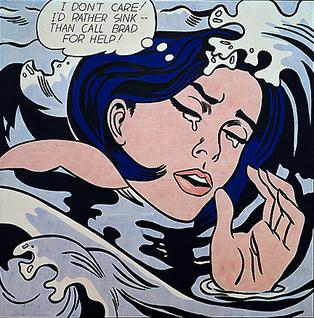Post-Modernism and Roy Lichtenstein:
Post-modernism is a philosophical movement created in reaction to the Modernist movement (Late 19th – early 20th century) and occurred straight after it, (Late 20th and early 21st centuries). It focuses on the role of language, power roles in genders and motivations in the formation of ideas and beliefs. It particularly emphasises and attacks the use of classifications such as; black versus white, gay versus straight and male versus female. Postmodernism recycles past styles and themes in a modern-day context, as well as the break-up of the barrier between fine and high arts and low art and popular culture.
One of the artists that were involved in this particular movement and the sub-movement of ‘pop-art’ was the artist Roy Lichtenstein, Who focused on using the popular art to show parodies of life, his favoured style being that of an old fashioned comic strip. He produced clean-cut, hard edged, precise work, detailing as well as presenting itself in a humorous manner. Both the popular advertising of time mixed with the rising popularity of comic books inspired Lichtenstein.
Lichtenstein used oil and magna paint for his best works, such as drowning girl (1963), and feature bold lines and the famous ‘Ben-day’ styled dots, to create the illusion that his works were in fact merely photographic copies.

“Abstract Expressionists put things down on the canvas and responded to what they had done, to the colour positions and sizes. My style looks completely different, but the nature of putting down lines pretty much is the same; mine just don't come out looking calligraphic, like Pollock's or Kline's." – Roy Lichtenstein
There was a lot of controversy about some of the pieces Lichtenstein produced as some of them were, even so altered; replicas of panels of comic books, many critiques questioned his originality, but Lichtenstein commented that he never tried to replicate the piece fully and the subject of his pieces were more focused about how the mass media production portrayed and “cleaned up” artists work.
References:
- Kimmelman, M. (1997). Roy Lichtenstein Dies Aged 73: New York Times Archives - http://www.nytimes.com/1997/09/30/arts/roy-lichtenstein-pop-master-dies-at-73.html
- Coplans, J. (1972). Roy Lichtenstein. Interviews, p55, 30, 31.
- Bernard, A. (1986), “BOMB Magazine” - http://bombsite.com/issues/14/articles/726
- Little, S. (2004). …isms: understanding art. P130 – 141.
No comments:
Post a Comment